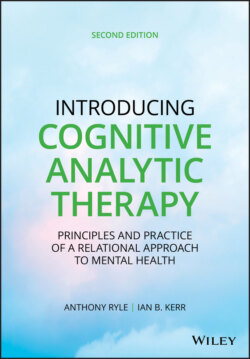Читать книгу Introducing Cognitive Analytic Therapy - Anthony Ryle - Страница 33
The Course of Therapy Initial Phase
ОглавлениеThe “phases” of therapy in CAT are seen as broadly conceived and will overlap considerably. They are not seen as completely separate compartments of a manualized approach, which CAT would see as unresponsive, dialogically inappropriate, and unhelpful. That said, by the end of the first few sessions a sequential model of problem procedures and a narrative reconstruction of their origins in the reformulation letter and map will usually have been jointly constructed and recorded. This may depend on, for example, the distress, disturbance, or distrust and wariness (seen as a RRP) of the patient, and correspondingly on the development of the therapeutic alliance. Paradoxically, with very distressed, disturbed, or angry patients it can be extremely helpful and containing to attempt to jot down a few words on paper almost immediately to acknowledge, validate, and capture some of the patient's current distress and its possible relational origins. Ideally, reformulation, and mapping in particular, should be seen as an ongoing part of the therapy dialog and not something that involves stopping therapy to undertake separately (see also Potter, 2017). Some therapists may feel more comfortable than others in working in this way, although it is also a clinical skill that can be acquired through experience. It may well be the case that therapeutic work on underlying RRs and their possibly traumatic context may not be desirable or possible at this stage (see, e.g., Carradice, 2013). But noting and acknowledging a patient’s broad subjective formative experience or “story” is usually extremely helpful, especially around a so‐called “difficult” patient (see also Chapters 10 and 11), and should always be an early aim. This demanding and often intense phase, culminating in explicit narrative and diagrammatic reformulations, usually creates a strong working alliance. As patients feel understood and “contained” by the reformulation, they are frequently able to recall memories and experience feelings that have been muted or denied. Such memories, feelings, or dreams may be supplemented by biographical writing or other forms of exploration such as drawing. Direct challenges to problematic or avoidant behaviors are seldom called for, and the phrase “coping strategy” or “coping pattern” is preferable to the potentially pejorative word “defense”. Symptoms, mood swings, and unwanted behaviors which had been monitored since the first session are increasingly understood in terms of their relation to the identified procedural patterns which are in need of revision. At this stage, the need to recognize problem procedures as they are manifest is emphasized, and the focus of routine self‐monitoring and diary keeping may shift from recording symptoms or moods to the identification of enacted problem RRs and RRPs. The classic “three Rs” of CAT are, in order, Reformulation, Recognition, and Revision. It is important to establish recognition before directing attention to revision, for one cannot reflect on or try to change that which has not been identified. It is also likely to be collusive, and reinforcing of formative RRs, to work simply on symptoms and behaviors. This early reformulation phase may in itself constitute an adequate basis for subsequent care planning, “team working” with and around a patient. It may also represent an adequate, “stand‐alone” form of mini‐therapy that may be powerful and helpful. This constitutes an increasing use of and application of CAT for whose effectiveness clinical evidence is accruing (see Chapters 9–11).
